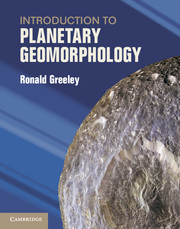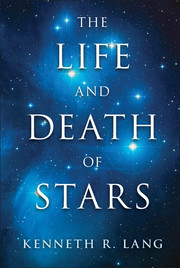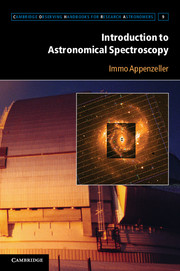Refine listing
Actions for selected content:
16950 results

Introduction to Planetary Geomorphology
-
- Published online:
- 05 February 2013
- Print publication:
- 21 February 2013

The Life and Death of Stars
-
- Published online:
- 05 February 2013
- Print publication:
- 25 March 2013

Understanding the Universe
- An Inquiry Approach to Astronomy and the Nature of Scientific Research
-
- Published online:
- 05 February 2013
- Print publication:
- 18 February 2013

Introduction to Astronomical Spectroscopy
-
- Published online:
- 05 January 2013
- Print publication:
- 17 December 2012
4 - Optical-Range Grating and Prism Spectrometers
-
- Book:
- Introduction to Astronomical Spectroscopy
- Published online:
- 05 January 2013
- Print publication:
- 17 December 2012, pp 81-126
-
- Chapter
- Export citation
9 - Special Techniques of the FIR and Submillimeter Range
-
- Book:
- Introduction to Astronomical Spectroscopy
- Published online:
- 05 January 2013
- Print publication:
- 17 December 2012, pp 214-223
-
- Chapter
- Export citation
5 - Other Techniques for the Optical Spectral Range
-
- Book:
- Introduction to Astronomical Spectroscopy
- Published online:
- 05 January 2013
- Print publication:
- 17 December 2012, pp 127-144
-
- Chapter
- Export citation
8 - Spectroscopy at Radio Wavelengths
-
- Book:
- Introduction to Astronomical Spectroscopy
- Published online:
- 05 January 2013
- Print publication:
- 17 December 2012, pp 200-213
-
- Chapter
- Export citation
Appendix: List of Acronyms
-
- Book:
- Introduction to Astronomical Spectroscopy
- Published online:
- 05 January 2013
- Print publication:
- 17 December 2012, pp 239-244
-
- Chapter
- Export citation
1 - Historical Remarks
-
- Book:
- Introduction to Astronomical Spectroscopy
- Published online:
- 05 January 2013
- Print publication:
- 17 December 2012, pp 1-25
-
- Chapter
- Export citation
Index
-
- Book:
- Introduction to Astronomical Spectroscopy
- Published online:
- 05 January 2013
- Print publication:
- 17 December 2012, pp 251-254
-
- Chapter
- Export citation
7 - UV, X-Ray, and Gamma Spectroscopy
-
- Book:
- Introduction to Astronomical Spectroscopy
- Published online:
- 05 January 2013
- Print publication:
- 17 December 2012, pp 179-199
-
- Chapter
- Export citation
Contents
-
- Book:
- Introduction to Astronomical Spectroscopy
- Published online:
- 05 January 2013
- Print publication:
- 17 December 2012, pp vii-x
-
- Chapter
- Export citation
6 - Preparing and Reducing Optical Observations
-
- Book:
- Introduction to Astronomical Spectroscopy
- Published online:
- 05 January 2013
- Print publication:
- 17 December 2012, pp 145-178
-
- Chapter
- Export citation
10 - New Developments and Future Prospects
-
- Book:
- Introduction to Astronomical Spectroscopy
- Published online:
- 05 January 2013
- Print publication:
- 17 December 2012, pp 224-238
-
- Chapter
- Export citation
2 - Spectroscopy in Present-Day Astronomy
-
- Book:
- Introduction to Astronomical Spectroscopy
- Published online:
- 05 January 2013
- Print publication:
- 17 December 2012, pp 26-49
-
- Chapter
- Export citation
Frontmatter
-
- Book:
- Introduction to Astronomical Spectroscopy
- Published online:
- 05 January 2013
- Print publication:
- 17 December 2012, pp i-vi
-
- Chapter
- Export citation
References
-
- Book:
- Introduction to Astronomical Spectroscopy
- Published online:
- 05 January 2013
- Print publication:
- 17 December 2012, pp 245-250
-
- Chapter
- Export citation
3 - Basic Physics of Spectral Measurements
-
- Book:
- Introduction to Astronomical Spectroscopy
- Published online:
- 05 January 2013
- Print publication:
- 17 December 2012, pp 50-80
-
- Chapter
- Export citation
Preface
-
- Book:
- Introduction to Astronomical Spectroscopy
- Published online:
- 05 January 2013
- Print publication:
- 17 December 2012, pp xi-xiv
-
- Chapter
- Export citation
